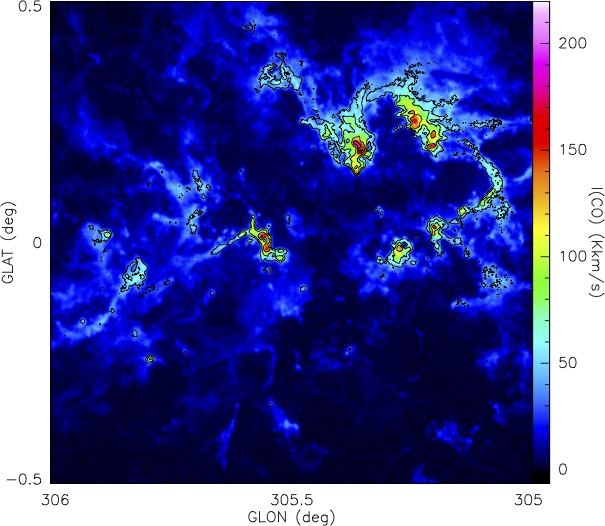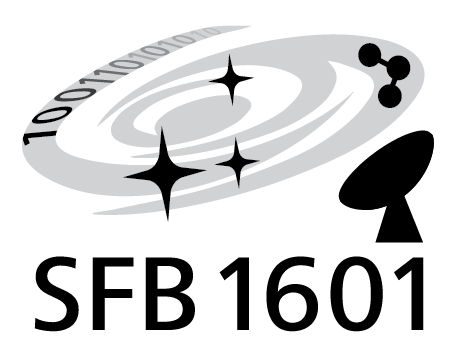Project leaders: Seifried, Daniel (PH1); Wyrowski, Friedrich (MPIfR)

Giant molecular clouds host the birthplaces of massive stars. Within them, coherent overdensities in form of parsec-scale massive dense clumps are the nurseries of star clusters. Fragmentation of the clumps then leads to the formation of individual stars or multiple systems. Current theoretical concepts triggered by new observational results focus more and more on the larger-scale environment of these birthplaces as crucial structures channelling the inflow of material from parsec scales to scales of disks and stars (see e. g. the global hierarchical collapse by Vázquez-Semadeni et al., MNRAS 490, 3061, 2019, and the inertial-inflow model by Padoan et al., ApJ 900, 82, 2020). Hence, the cloud and clump reservoirs are essential for the formation of massive star clusters that subsequently disperse first their clump environment and with time the larger-scale molecular cloud structures.
Here we aim at characterising in detail the important gas properties on clump scales of a fraction of a parsec to several parsecs, bridging the gap between high angular resolution studies, as conducted in Project Section A and the larger cloud scales, that can now be resolved in nearby galaxies. While the last years have seen significant progress in unbiased surveys revealing complete samples of dense clumps in our Milky Way (e.g. ATLASGAL, Urquhart et al., MNRAS 473, 1059, 2018, and HiGAL, Elia et al., MNRAS 504, 2742, 2021), the processes governing the formation and dispersion of these clumps remain poorly understood. Also from the theoretical side there is still an ongoing debate to which extent clumps and cores are gravitationally bound structures or, at least to some fraction, transient features (e.g. Ballesteros-Paredes et al., MNRAS 479, 2112, 2018). This question holds even more true for the ambient gas feeding these structures, reflected in concurring models of molecular clouds (e.g. the gravo-turbulent model, e.g. Klessen, ApJ 556, 837, 2001 vs. the global, hierachical collapse model, e. g. Vázquez-Semadeni et al., MNRAS 490, 3061, 2019). In B1 we plan to approach this topic from the observational and theoretical side by means of two different work packages (WPs), B1.1 and B1.2.

G305 molecular cloud complex with a spatial resolution of about 0.3 pc (adapted from Mazumdar et al. 2021a).
Publications
2025
On the origin of V-shaped polarization spectra in molecular clouds Journal Article
In: Monthly Notices of the RAS, vol. 542, no. 4, pp. 3302-3314, 2025.
A compact Keplerian-like disc and H30 ensuremathalpha emission towards the radio jet in the massive protostar W75N(B)-VLA3 Journal Article
In: Monthly Notices of the RAS, vol. 543, no. 1, pp. 662-690, 2025.
The Rosetta Stone project. III. ALMA synthetic observations of fragmentation in high-mass star-forming clumps Journal Article
In: A&A, vol. 701, no. A219, pp. arXiv:2507.11032, 2025.
The Diamond Ring in Cygnus X: Advanced stage of an expanding bubble of ionised carbon Journal Article
In: Astronomy & Astrophysics, vol. 703, iss. A197, pp. 14, 2025.
The HI-to-H2 transition in the Draco cloud Journal Article
In: Astronomy & Astrophysics, no. aa55308-25corr, pp. 2025A&A...699A.354S, 2025.
SILCC – IX. The multi-phase interstellar medium at low metallicity Journal Article
In: MNRAS, vol. 543, no. 4, pp. 4286-4311, 2025.
The impact of cosmic-ray heating on the cooling of the low-metallicity interstellar medium Journal Article
In: Monthly Notices of the RAS, vol. 537, no. 1, pp. 482-499, 2025.
How do supernova remnants cool?: II. Machine learning analysis of supernova remnant simulations Journal Article
In: A&A, vol. 693, pp. A38, 2025.
2024
The origin and evolution of the [CII] deficit in HII regions and star-forming molecular clouds Journal Article
In: A&A, vol. 692, pp. A58, 2024.
High-resolution observations of 12CO and 13CO J = 3 → 2 towards the NGC 6334 extended filament: I. Emission morphology and velocity structure Journal Article
In: A&A, vol. 692, pp. A114, 2024.
HYACINTH: HYdrogen And Carbon chemistry in the INTerstellar medium in Hydro simulations Journal Article
In: A&A, vol. 688, pp. A194, 2024.
On the evolution of the observed mass-to-length relationship for star-forming filaments Journal Article
In: Monthly Notices of the RAS, vol. 528, no. 4, pp. 6370-6387, 2024.
SILCC-Zoom: the dynamic balance in molecular cloud substructures Journal Article
In: Monthly Notices of the RAS, vol. 528, no. 2, pp. 3630-3657, 2024.
References
- Giannetti, Leurini, Wyrowski, Urquhart, Csengeri, Menten, König, and Güsten, “ATLASGAL-selected massive clumps in the inner Galaxy. V. Temperature structure and evolution”, A&A 603, A33 (2017).
- Grassi, Bovino, Schleicher, Prieto, Seifried, Simoncini, and Gianturco, “KROME – a package to embed chemistry in astrophysical simulations”, MNRAS 439, 2386 (2014).
- Kim, Wyrowski, Urquhart, Pérez-Beaupuits, Pillai, Tiwari, and Menten, “ATLASGAL-selected massive clumps in the inner Galaxy. VIII. Chemistry of photodissociation regions”, A&A 644, A160 (2020).
- Mattern, Kauffmann, Csengeri, Urquhart, Leurini, Wyrowski, Giannetti, Barnes, et al., “SEDIGISM: thekinematics of ATLASGAL filaments”, A&A 619, A166 (2018).
- Sabatini, Bovino, Giannetti, Wyrowski, Órdenes, Pascale, Pillai, Wienen, et al., “Survey of ortho-H2D+in high-mass star-forming regions”, A&A 644, A34 (2020).
- Schuller, Urquhart, Csengeri, Colombo, and 56 co-authors including, Wyrowski, Menten, and Schilke,“The SEDIGISM survey: First Data Release and overview of the Galactic structure”, MNRAS 500,3064 (2021).
- Seifried, Haid, Walch, Borchert, and Bisbas, “SILCC-Zoom: H2 and CO-dark gas in molecular clouds- the impact of feedback and magnetic fields”, MNRAS 492, 1465 (2020).
- Seifried and Walch, “Modelling the chemistry of star-forming filaments – I. H2 and CO chemistry”,MNRAS 459, L11 (2016).
- Seifried, Walch, Girichidis, Naab, Wünsch, Klessen, Glover, Peters, et al., “SILCC-Zoom: the dynamicand chemical evolution of molecular clouds”, MNRAS 472, 4797 (2017).
- Wyrowski, Güsten, Menten, Wiesemeyer, Csengeri, Heyminck, Klein, König, et al., “Infall through the evolution of high-mass star-forming clumps”, A&A 585, A149 (2016).
